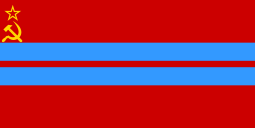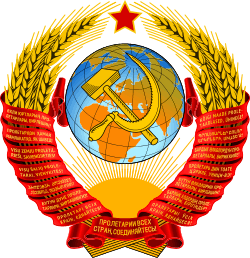Turkmen Soviet Socialist Republic
| Turkmen Soviet Socialist Republic | ||||||||||||||
| Түркменистан Совет Социалистик Республикасы Türkmenistan Sowet Sotsialistik Respublikasy Туркменская Советская Социалистическая Республика | ||||||||||||||
| ||||||||||||||
| ||||||||||||||
| Anthem Anthem of Turkmen SSR | ||||||||||||||
 Location of the Turkmen SSR (red) within the Soviet Union. | ||||||||||||||
| Capital | Ashkhabad | |||||||||||||
| Languages | Turkmen Russian | |||||||||||||
| Government | Soviet Socialist Republic | |||||||||||||
| First Secretary | ||||||||||||||
| • | 1924–1926 | Ivan Mezhlauk | ||||||||||||
| • | 1985–1991 | Saparmurat Niazov | ||||||||||||
| History | ||||||||||||||
| • | Turkmen Oblast of the Turkestan ASSR | 7 August 1921 | ||||||||||||
| • | Established | 13 May 1925 | ||||||||||||
| • | Sovereignty declared | 22 August 1990 | ||||||||||||
| • | Independence declared | 27 October 1991 | ||||||||||||
| • | Independence recognized | 26 December 1991 | ||||||||||||
| • | New Turkmen Constitution | 8 May 1992 | ||||||||||||
| Area | ||||||||||||||
| • | 1989 | 488,100 km² (188,456 sq mi) | ||||||||||||
| Population | ||||||||||||||
| • | 1989 est. | 3,522,700 | ||||||||||||
| Density | 7.2 /km² (18.7 /sq mi) | |||||||||||||
| Calling code | +7 360/363/370/378/432 | |||||||||||||
| ||||||||||||||
| Today part of | | |||||||||||||
Part of a series on the |
|---|
| History of Turkmenistan |
 |
|
The Turkmen Soviet Socialist Republic (Turkmen SSR; Turkmen: Түркменистан Совет Социалистик Республикасы, Türkmenistan Sowet Sotsialistik Respublikasy; Russian: Туркменская Советская Социалистическая Республика, Turkmenskaya Sovetskaya Sotsialisticheskaya Respublika), also commonly known as Soviet Turkmenistan or simply Turkmenistan was one of the constituent republics of the Soviet Union located in Central Asia. Initially, on 7 August 1921, it was established as the Turkmen Oblast of the Turkestan ASSR before being made, on 13 May 1925, a separate republic of the USSR as the Turkmen SSR.
Since then the borders of the Turkmenistan were unchanged. On 22 August 1990, Turkmenistan declared its sovereignty over Soviet laws. On 27 October 1991, it became independent and Turkmen SSR was renamed to Turkmenistan although the new Constitution of Turkmenistan was adopted on 8 May 1992.
Geographically, Turkmenistan was bordered between Iran, Afghanistan to the south, Caspian Sea to the west, Kazakhstan to the north and Uzbekistan to the east.
History
Annexation to Russia
Russian attempts to encroach upon Turkmen territory began in earnest in the latter part of the nineteenth century. Of all the Central Asian peoples, the Turkmen put up the stiffest resistance against Russian expansion. In 1869 the Russian Empire established a foothold in present-day Turkmenistan with the foundation of the Caspian Sea port of Krasnovodsk (now Türkmenbaşy). From there and other points, they marched on and subdued the Khiva Khanate in 1873. Because Turkmen tribes, most notably the Yomud, were in the military service of the Khivan khan, Russian forces undertook punitive raids against Khorazm, in the process slaughtering hundreds of Turkmen and destroying their settlements. In 1881 the Russians under General Mikhail Skobelev besieged and captured Geok Tepe, one of the last Turkmen strongholds, northwest of Ashgabat. With the Turkmen defeat (which is now marked by the Turkmen as a national day of mourning and a symbol of national pride), the annexation of what is present-day Turkmenistan met with only weak resistance. Later the same year, the Russians signed an agreement with the Persians and established what essentially remains the current border between Turkmenistan and Iran. In 1897 a similar agreement was signed between the Russians and Afghans.[1]
Following annexation to Russia, the area was administered as the Transcaspian Region by corrupt and malfeasant military officers and officials appointed by the Turkestan Governor-Generalship in Tashkent. In the 1880s, a railroad was built from Krasnovodsk to Ashgabat and later extended to Tashkent. Urban areas began to develop along the railway. Although the Transcaspian Region essentially was a colony of Russia, it remained a backwater, except for Russian concerns with British colonialist intentions in the region and with possible uprisings by the Turkmen.[1]
Creation of SSR
Because the Turkmen generally were indifferent to the advent of Soviet rule in 1917, little revolutionary activity occurred in the region in the years that followed. However, the years immediately preceding the revolution had been marked by sporadic Turkmen uprisings against Russian rule, most prominently the anti-tsarist revolt of 1916 that swept through the whole of Turkestan. Their armed resistance to Soviet rule was part of the larger Basmachi Revolt throughout Central Asia from the 1920s into the early 1930s, which included most of the future USSR dependencies. Although Soviet sources describe this struggle as a minor chapter in the republic's history, it is clear that opposition was fierce and resulted in the death of large numbers of Turkmen.[2]
In October 1924, when Central Asia was divided into distinct political entities, the Transcaspian Region and Turkmen Oblast of the Turkestan Autonomous Soviet Socialist Republic (Turkestan ASSR) became the Turkmen Soviet Socialist Republic (Turkmen SSR), a full-fledged constituent republic of the Soviet Union. During the forced collectivization and other extreme socioeconomic changes of the first decades of Soviet rule, pastoral nomadism ceased to be an economic alternative in Turkmenistan, and by the late 1930s the majority of Turkmen had become sedentary. Efforts by the Soviet state to undermine the traditional Turkmen way of life resulted in significant changes in familial and political relationships, religious and cultural observances, and intellectual developments. Significant numbers of Russians and other Slavs, as well as groups from various nationalities mainly from the Caucasus, migrated to urban areas. Modest industrial capabilities were developed, and limited exploitation of Turkmenistan's natural resources was initiated.[2]
Under Soviet rule, all religious beliefs were attacked by the communist authorities as superstition and "vestiges of the past." Most religious schooling and religious observance were banned, and the vast majority of mosques were closed. An official Muslim Board of Central Asia with a headquarters in Tashkent was established during World War II to supervise the Islam faith in Central Asia. For the most part, the Muslim Board functioned as an instrument of propaganda whose activities did little to enhance the Muslim cause. Atheist indoctrination stifled religious development and contributed to the isolation of the Turkmen from the international Muslim community. Some religious customs, such as Muslim burial and male circumcision, continued to be practiced throughout the Soviet period, but most religious belief, knowledge, and customs were preserved only in rural areas in "folk form" as a kind of unofficial Islam not sanctioned by the state-run Spiritual Directorate.[3]
Pre-independence
Beginning in the 1930s, Moscow kept the republic under firm control. The nationalities policy of the Communist Party of the Soviet Union (CPSU) fostered the development of a Turkmen political elite and promoted Russification. Slavs, both in Moscow and Turkmenistan, closely supervised the national cadre of government officials and bureaucrats; generally, the Turkmen leadership staunchly supported Soviet policies. Moscow initiated nearly all political activity in the republic, and, except for a corruption scandal in the mid-1980s that ousted longtime First Secretary Muhammetnazar Gapurow, Turkmenistan remained a quiet Soviet republic. Foreigners and even most Soviet citizens couldn't visit the area. Most Turkmen couldn't leave the republic either.[4] Mikhail S. Gorbachev's policies of glasnost and perestroika did not have a significant impact on Turkmenistan, as many people there were self-dependent, and settlers of the territory and the Soviet Union's ministers rarely intertwined. The republic found itself rather unprepared for the dissolution of the Soviet Union and the independence that followed in 1991.[5]
When other constituent republics of the Soviet Union advanced claims to sovereignty in 1988 and 1989, Turkmenistan's leadership also began to criticize Moscow's economic and political policies as exploitative and detrimental to the well-being and pride of the Turkmen. By a unanimous vote of its Supreme Soviet, Turkmenistan declared its sovereignty in August 1990. After the August 1991 coup attempt against the Gorbachev regime in Moscow, Turkmenistan's communist leader Saparmurat Niyazov called for a popular referendum on independence. The official result of the referendum was 94 percent in favor of independence. The republic's Supreme Soviet had little choice other than to declare Turkmenistan's independence from the Soviet Union and the establishment of the Republic of Turkmenistan on October 27, 1991.[5] Turkmenistan received independence from the Soviet Union on December 25, 1991.
See also
Notes
- 1 2 Curtis (1996). "Turkmenistan: Incorporation into Russia".
- 1 2 Curtis (1996). "Turkmenistan: Soviet Turkmenistan".
- ↑ Curtis (1996). "Turkmenistan: History and Structure".
- ↑ name=http://www.globalsecurity.org/military/world/centralasia/turkmen-history-3.htm.
- 1 2 Curtis (1996). "Turkmenistan: Sovereignty and Independence".
References
![]() This article incorporates public domain material from the Library of Congress Country Studies website http://lcweb2.loc.gov/frd/cs/.
This article incorporates public domain material from the Library of Congress Country Studies website http://lcweb2.loc.gov/frd/cs/.
- Curtis, Glenn E. (1996). Turkmenistan: A Country Study. Library of Congress Country Studies. Washington: United States Government Printing Office. OCLC 45380435.
External links
Coordinates: 37°58′N 58°20′E / 37.967°N 58.333°E


